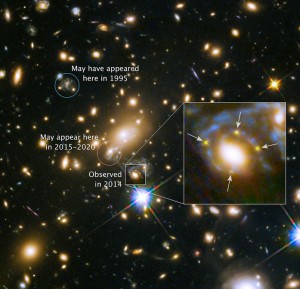Associate Prof. Marusa Bradac and the GLASS collaboration spot for the first time a supernova arranged in an "Einstein’s Cross."
Cosmic lens splits supernova into four images
March 5th, 2015 @ 11:00 am by Andy Fell
Hubble Space Telescope have for the first time spotted four images of the same distant exploding star, arranged in an "Einstein's Cross," a cross-shape pattern created by the powerful gravity of a foreground galaxy embedded in a massive cluster of galaxies.

Distant supernova split into four images by massive galaxy cluster in the four ground. Because light is taking different paths through the cluster, other images of the supernova may appear later.
First predicted by Albert Einstein, gravitational lensing is similar to a glass lens bending light to magnify and distort the image of an object behind it.
Although astronomers have discovered dozens of multiply imaged galaxies and quasars, they have never seen a stellar explosion resolved into several images.
The lensed supernova was found by the Grism Lens Amplified Survey from Space (GLASS) collaboration. The GLASS group is working with the FrontierSN team to analyze the supernova. A paper describing the discovery appeared March 6 in a special issue of the journal Science celebrating the centenary of Albert Einstein's Theory of General Relativity.
"Until now, we've only been able to study galaxies that are multiply lensed," said Marusa Bradac, an astronomer in the UC Davis Department of Physics and coauthor on the paper. "For the first time we now see a supernova in this role and this is extremely exciting."
This unique observation will help astronomers refine their estimates of the amount and distribution of dark matter in the lensing galaxy and cluster. Dark matter cannot be seen directly but is believed to make up most of the universe's mass.
"These kinds of systems are pure gold, because they allow us to study the supernova and the dark matter in the galaxy, as well as determine the history of the entire Universe," Bradac said.
A supernova is a short-lived event, but when the four images fade away astronomers will have a rare chance to catch a rerun because the current four-image pattern is only one component of the lensing display. The clumps of dark matter in the galaxy cluster are bending images of the supernova through multiple different routes, like train tracks through a mountain range. The supernova may have appeared in a single image some 20 years ago, and it is expected to reappear once more in the next one to five years.
The prediction of a future appearance is based on computer models of the cluster, which describe the various paths the divided light is taking through the maze of clumpy dark matter in the galactic grouping. The supernova images do not arrive at Earth at the same time because some of the light is delayed as it travels around bends created by the gravity of dense dark matter in the intervening galaxy cluster.
"Our model for the dark matter in the cluster gives us the prediction of when the next image will appear because it tells us how long each train track is, which correlates with time," said Steve Rodney of Johns Hopkins University, leader of the FrontierSN team. "We already missed one that we think appeared about 20 years ago, and we found these four images after they had already appeared. The prediction of this future image is the one that is most exciting because we might be able to catch it. We hope to come back to this field with Hubble, and we'll keep looking to see when that expected next image appears."
Measuring the time delays between images will help the astronomers fine-tune the models that map out the cluster's mass.
Patrick Kelly of UC Berkeley spotted the four images of the exploding star on Nov. 11, 2014, in the galaxy cluster MACS J1149.6+2223, located more than 5 billion light-years away. The FrontierSN and GLASS teams teams spent a week analyzing the object's light, confirming it was the signature of a supernova. They then turned to the W. M. Keck Observatory on Mauna Kea, in Hawaii, to measure the distance to the supernova's host galaxy, which is 9.3 billion light-years from Earth.
The supernova appears about 20 times brighter than its natural brightness, because it is being magnified by both the lens of the galaxy cluster and by a massive elliptical galaxy within the cluster.
The astronomers nicknamed the supernova Refsdal in honor of Norwegian astronomer Sjur Refsdal, who, in 1964, first proposed using time-delayed images from a lensed supernova to study the expansion of the universe.
Image credits: NASA, ESA, and S. Rodney (JHU) and the FrontierSN team; T. Treu (UCLA), P. Kelly (UC Berkeley) and the GLASS team; J. Lotz (STScI) and the Frontier Fields Team; M. Postman (STScI) and the CLASH team; and Z. Levay (STScI)
Adapted from a NASA news release.
Published: March 2, 2015, 11:00 am
